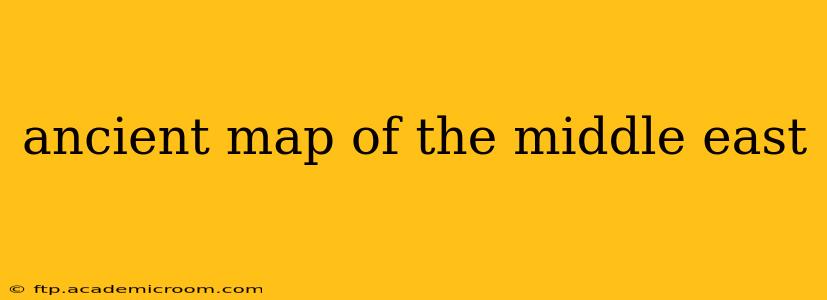The Middle East, a cradle of civilization, boasts a rich and complex history reflected in its ancient maps. These cartographic artifacts, though often incomplete or stylized, offer invaluable insights into the geographical understanding, political boundaries, and cultural perspectives of past eras. From the rudimentary sketches of early explorers to the more sophisticated creations of later cartographers, these maps provide a fascinating window into the past. This exploration delves into the world of ancient Middle Eastern maps, examining their creation, significance, and enduring legacy.
What are the oldest known maps of the Middle East?
Pinpointing the absolute "oldest" map is challenging due to the fragmentary nature of many surviving ancient documents and the continuous evolution of cartographic techniques. However, some of the earliest known depictions of Middle Eastern regions are found on clay tablets from Mesopotamia dating back to the third millennium BCE. These tablets often depict specific regions, cities, or waterways, rather than comprehensive maps in the modern sense. They are less about precise geographical representation and more about conveying spatial relationships relevant to the time. Later, we find increasingly sophisticated maps emerging from various ancient civilizations, including the Greeks, Romans, and Arabs.
How were ancient maps of the Middle East created?
Ancient mapmaking techniques varied significantly depending on the available materials and technological advancements. Early Mesopotamian maps were often etched onto clay tablets, with features represented symbolically. Later civilizations utilized papyrus, parchment, and eventually paper, allowing for greater detail and complexity. The creation process involved a combination of observation, surveying, and often, a blending of factual knowledge with mythological or symbolic elements. These maps weren’t purely scientific endeavors; they were often infused with the cultural and political biases of their creators.
What information do ancient Middle Eastern maps provide?
Ancient maps of the Middle East offer a wealth of information extending beyond simple geographical representation. They reveal:
- Geographical knowledge: The depiction of rivers, mountains, coastlines, and settlements provides insight into the level of geographical understanding at the time.
- Political boundaries: Maps often reflect the political landscape, showing empires, kingdoms, and tribal territories, offering valuable information on the shifting power dynamics of the region.
- Trade routes: The illustration of significant routes reveals the economic networks connecting different regions, highlighting the importance of trade in shaping the cultural landscape.
- Cultural perspectives: Symbolism and stylistic choices integrated into the maps often reveal cultural beliefs and values of the creators. For instance, the positioning of cities or the inclusion of mythical elements can highlight religious beliefs or historical narratives.
What are some examples of famous ancient maps of the Middle East?
While many ancient maps are fragmented or lost to time, several notable examples exist, though often only in copies or fragments. Researchers are constantly studying newly discovered or rediscovered maps, adding to our understanding of ancient cartography. Access to these maps is often limited to academic institutions and specialist collections, making their study a complex and ongoing process. Specific examples require detailed research within academic archives and often aren't readily available online for public viewing.
How accurate were ancient maps of the Middle East?
The accuracy of ancient maps varied considerably depending on their purpose, the technology available, and the geographical knowledge of their creators. Early maps tended to be less geographically precise, focusing on relative locations and important features. Later maps, particularly those produced by the Greeks and Romans, demonstrate a greater level of accuracy, though even these maps often incorporated inaccuracies due to limitations in surveying techniques and geographical understanding. It's crucial to remember that these maps represent the worldview of their time, not necessarily objective geographical accuracy by modern standards.
Where can I find images or information about ancient maps of the Middle East?
Information on ancient maps can often be found in academic journals, museum archives, and specialized books on cartography and the history of the Middle East. Many universities and research institutions hold significant collections of historical maps, though these are frequently not available for online public viewing due to conservation requirements or limited digitalization efforts. Exploring the online resources of major museums and historical societies with relevant collections can provide some access, though the extent of what's available digitally remains limited.
This exploration serves as an introduction to the fascinating world of ancient Middle Eastern maps. Further research is encouraged to delve deeper into the intricacies of these historical artifacts and their enduring contribution to our understanding of the past. The study of these maps is a continuing field of research, continually revealing new information as scholars continue their work.
